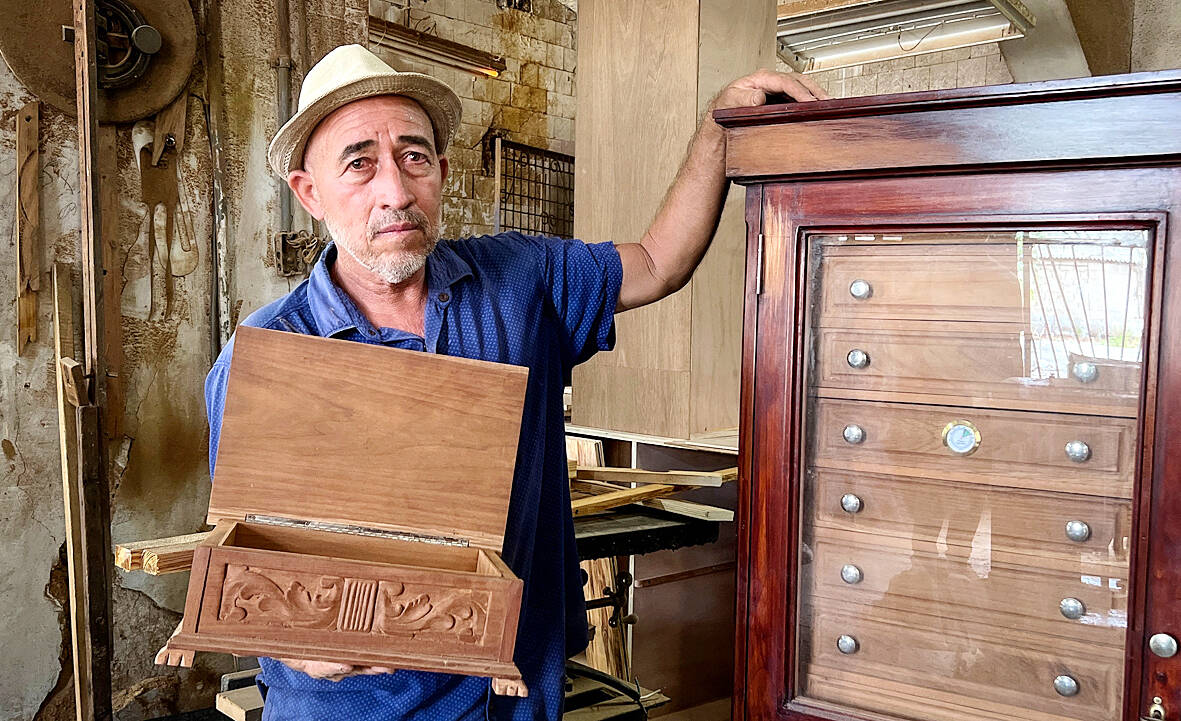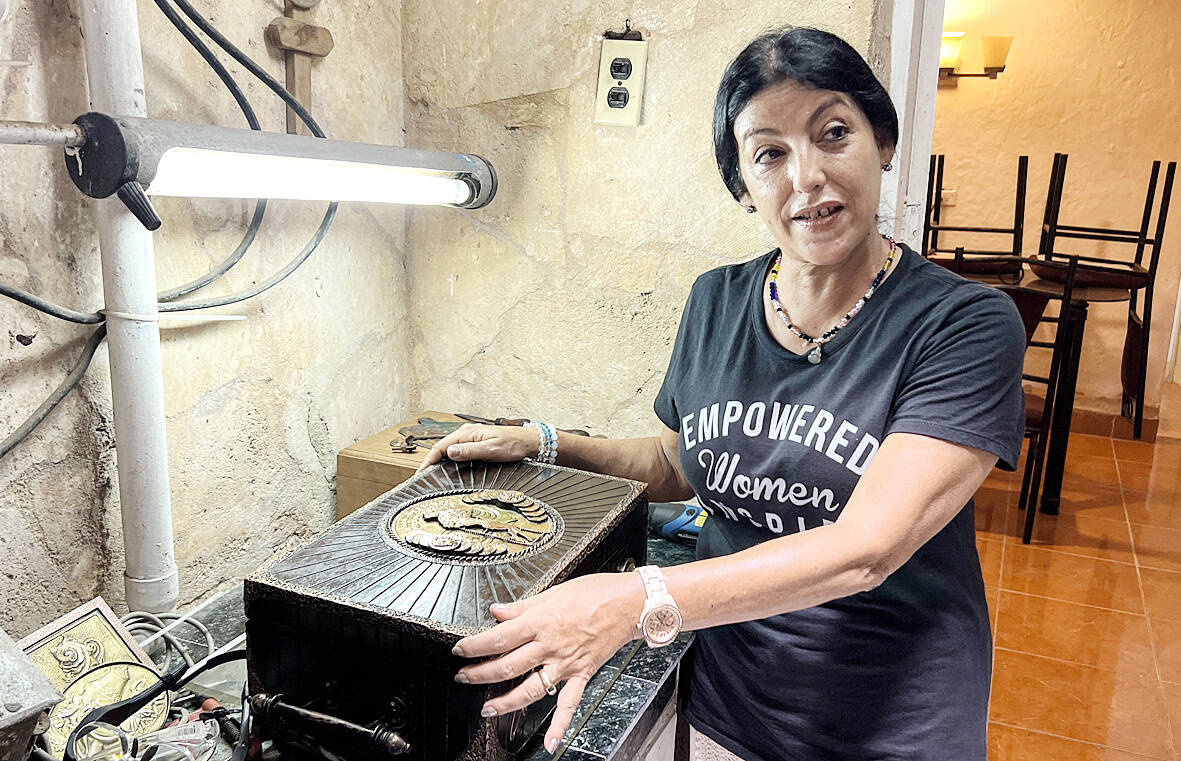Using a Soviet-era planer, Rene Reyes smooths the panel of an old cedar door that he will transform into a humidor — an ornate, handmade box used to preserve Cuba’s famous cigars. In a corner of the workshop lies a hodge-podge of discarded wooden beams, doors and furniture, all used to make the cigar boxes, which can sell for thousands of dollars and are prized by wealthy business people, rock stars and presidents.
“People don’t believe that ... these humidors come from there,” says Reyes, pointing to the pile of raw materials.
The artisan is working on the replica of a modest humidor owned by American writer Ernest Hemingway, the original of which is displayed at his former home in eastern Havana, which is now a museum.

Photo: AFP
As he brushes the door panel, which he says is over 80 years old, the warm and sweet aroma of old cedar fills the workshop.
“The smell of cedar is the best. It is as if it were gold, old gold,” Reyes gushes as he brings his hands full of sawdust to his nose.
Reyes works for businesswoman Tania Duyos, who has spent two decades designing the boxes that keep cigars at the perfect humidity of around 65 or 70 percent and a temperature of 16 to 18 degrees Celsius.

Photo: AFP
She boasts celebrity clients such as former US president Jimmy Carter, the late footballer Diego Maradona, and Rolling Stones frontman Mick Jagger.
Duyos says she also gifted one of her cigar boxes to another former US president, Barack Obama, during his historic 2016 visit to the island, and that he wrote her a thank you letter.
Cuban cigars are one of the island’s most famous exports and are considered among the finest in the world. Dozens of humidor workshops can be found across the country. Experts say a good humidor can preserve the quality of a cigar for up to 15 years, and even improve it.
Cuban artisans use several types of wood, such as mahogany or ebony, but tradition dictates that the interior must be made from old cedar.
“Cedar is very favorable” because “it protects the tobacco from bacteria and provides it with the humidity,” necessary for its conservation, Duyos says. If kept in the wrong environment, even the best cigar loses its quality.
With carved, embossed or painted designs, some of the chests are true works of art and are coveted by collectors.
While some are sold for eye-watering prices, more modest versions are also available on the local market.
Every year, the Habano Festival — dedicated to cigar enthusiasts — closes with a humidor auction.
In February, the auction of six cigar boxes raised a record US$11.9 million. The star of the show was an exquisite, circular piece, one meter deep, made of precious woods, with titanium and bronze touches.
Containing 500 of the best Cohiba cigars — the most prestigious from the island — it sold for US$4.4 million.
Duyos admits that in Cuba, which has been under American sanctions for over half a century and gripped by the worst economic crisis in 30 years, you need to adapt to shortages of glue, sealants, varnish, sandpaper or tools.
“We practically work wonders with nothing,” said Reyes. “The secret is the love” of the job.

The Taipei Times last week reported that the rising share of seniors in the population is reshaping the nation’s housing markets. According to data from the Ministry of the Interior, about 850,000 residences were occupied by elderly people in the first quarter, including 655,000 that housed only one resident. H&B Realty chief researcher Jessica Hsu (徐佳馨), quoted in the article, said that there is rising demand for elderly-friendly housing, including units with elevators, barrier-free layouts and proximity to healthcare services. Hsu and others cited in the article highlighted the changing family residential dynamics, as children no longer live with parents,

It is jarring how differently Taiwan’s politics is portrayed in the international press compared to the local Chinese-language press. Viewed from abroad, Taiwan is seen as a geopolitical hotspot, or “The Most Dangerous Place on Earth,” as the Economist once blazoned across their cover. Meanwhile, tasked with facing down those existential threats, Taiwan’s leaders are dying their hair pink. These include former president Tsai Ing-wen (蔡英文), Vice President Hsiao Bi-khim (蕭美琴) and Kaohsiung Mayor Chen Chi-mai (陳其邁), among others. They are demonstrating what big fans they are of South Korean K-pop sensations Blackpink ahead of their concerts this weekend in Kaohsiung.

Taiwan is one of the world’s greatest per-capita consumers of seafood. Whereas the average human is thought to eat around 20kg of seafood per year, each Taiwanese gets through 27kg to 35kg of ocean delicacies annually, depending on which source you find most credible. Given the ubiquity of dishes like oyster omelet (蚵仔煎) and milkfish soup (虱目魚湯), the higher estimate may well be correct. By global standards, let alone local consumption patterns, I’m not much of a seafood fan. It’s not just a matter of taste, although that’s part of it. What I’ve read about the environmental impact of the

Oct 20 to Oct 26 After a day of fighting, the Japanese Army’s Second Division was resting when a curious delegation of two Scotsmen and 19 Taiwanese approached their camp. It was Oct. 20, 1895, and the troops had reached Taiye Village (太爺庄) in today’s Hunei District (湖內), Kaohsiung, just 10km away from their final target of Tainan. Led by Presbyterian missionaries Thomas Barclay and Duncan Ferguson, the group informed the Japanese that resistance leader Liu Yung-fu (劉永福) had fled to China the previous night, leaving his Black Flag Army fighters behind and the city in chaos. On behalf of the